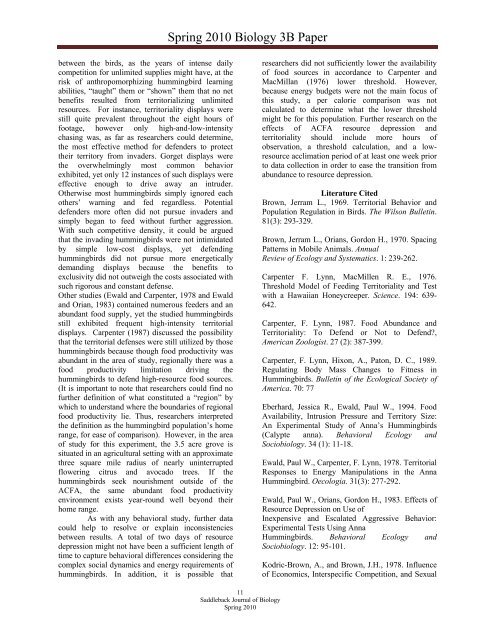Saddleback Journal of Biology - Saddleback College
Saddleback Journal of Biology - Saddleback College
Saddleback Journal of Biology - Saddleback College
You also want an ePaper? Increase the reach of your titles
YUMPU automatically turns print PDFs into web optimized ePapers that Google loves.
Spring 2010 <strong>Biology</strong> 3B Paper<br />
between the birds, as the years <strong>of</strong> intense daily<br />
competition for unlimited supplies might have, at the<br />
risk <strong>of</strong> anthropomorphizing hummingbird learning<br />
abilities, “taught” them or “shown” them that no net<br />
benefits resulted from territorializing unlimited<br />
resources. For instance, territoriality displays were<br />
still quite prevalent throughout the eight hours <strong>of</strong><br />
footage, however only high-and-low-intensity<br />
chasing was, as far as researchers could determine,<br />
the most effective method for defenders to protect<br />
their territory from invaders. Gorget displays were<br />
the overwhelmingly most common behavior<br />
exhibited, yet only 12 instances <strong>of</strong> such displays were<br />
effective enough to drive away an intruder.<br />
Otherwise most hummingbirds simply ignored each<br />
others’ warning and fed regardless. Potential<br />
defenders more <strong>of</strong>ten did not pursue invaders and<br />
simply began to feed without further aggression.<br />
With such competitive density, it could be argued<br />
that the invading hummingbirds were not intimidated<br />
by simple low-cost displays, yet defending<br />
hummingbirds did not pursue more energetically<br />
demanding displays because the benefits to<br />
exclusivity did not outweigh the costs associated with<br />
such rigorous and constant defense.<br />
Other studies (Ewald and Carpenter, 1978 and Ewald<br />
and Orian, 1983) contained numerous feeders and an<br />
abundant food supply, yet the studied hummingbirds<br />
still exhibited frequent high-intensity territorial<br />
displays. Carpenter (1987) discussed the possibility<br />
that the territorial defenses were still utilized by those<br />
hummingbirds because though food productivity was<br />
abundant in the area <strong>of</strong> study, regionally there was a<br />
food productivity limitation driving the<br />
hummingbirds to defend high-resource food sources.<br />
(It is important to note that researchers could find no<br />
further definition <strong>of</strong> what constituted a “region” by<br />
which to understand where the boundaries <strong>of</strong> regional<br />
food productivity lie. Thus, researchers interpreted<br />
the definition as the hummingbird population’s home<br />
range, for ease <strong>of</strong> comparison). However, in the area<br />
<strong>of</strong> study for this experiment, the 3.5 acre grove is<br />
situated in an agricultural setting with an approximate<br />
three square mile radius <strong>of</strong> nearly uninterrupted<br />
flowering citrus and avocado trees. If the<br />
hummingbirds seek nourishment outside <strong>of</strong> the<br />
ACFA, the same abundant food productivity<br />
environment exists year-round well beyond their<br />
home range.<br />
As with any behavioral study, further data<br />
could help to resolve or explain inconsistencies<br />
between results. A total <strong>of</strong> two days <strong>of</strong> resource<br />
depression might not have been a sufficient length <strong>of</strong><br />
time to capture behavioral differences considering the<br />
complex social dynamics and energy requirements <strong>of</strong><br />
hummingbirds. In addition, it is possible that<br />
researchers did not sufficiently lower the availability<br />
<strong>of</strong> food sources in accordance to Carpenter and<br />
MacMillan (1976) lower threshold. However,<br />
because energy budgets were not the main focus <strong>of</strong><br />
this study, a per calorie comparison was not<br />
calculated to determine what the lower threshold<br />
might be for this population. Further research on the<br />
effects <strong>of</strong> ACFA resource depression and<br />
territoriality should include more hours <strong>of</strong><br />
observation, a threshold calculation, and a lowresource<br />
acclimation period <strong>of</strong> at least one week prior<br />
to data collection in order to ease the transition from<br />
abundance to resource depression.<br />
Literature Cited<br />
Brown, Jerram L., 1969. Territorial Behavior and<br />
Population Regulation in Birds. The Wilson Bulletin.<br />
81(3): 293-329.<br />
Brown, Jerram L., Orians, Gordon H., 1970. Spacing<br />
Patterns in Mobile Animals. Annual<br />
Review <strong>of</strong> Ecology and Systematics. 1: 239-262.<br />
Carpenter F. Lynn, MacMillen R. E., 1976.<br />
Threshold Model <strong>of</strong> Feeding Territoriality and Test<br />
with a Hawaiian Honeycreeper. Science. 194: 639-<br />
642.<br />
Carpenter, F. Lynn, 1987. Food Abundance and<br />
Territoriality: To Defend or Not to Defend?,<br />
American Zoologist. 27 (2): 387-399.<br />
Carpenter, F. Lynn, Hixon, A., Paton, D. C., 1989.<br />
Regulating Body Mass Changes to Fitness in<br />
Hummingbirds. Bulletin <strong>of</strong> the Ecological Society <strong>of</strong><br />
America. 70: 77<br />
Eberhard, Jessica R., Ewald, Paul W., 1994. Food<br />
Availability, Intrusion Pressure and Territory Size:<br />
An Experimental Study <strong>of</strong> Anna’s Hummingbirds<br />
(Calypte anna). Behavioral Ecology and<br />
Sociobiology. 34 (1): 11-18.<br />
Ewald, Paul W., Carpenter, F. Lynn, 1978. Territorial<br />
Responses to Energy Manipulations in the Anna<br />
Hummingbird. Oecologia. 31(3): 277-292.<br />
Ewald, Paul W., Orians, Gordon H., 1983. Effects <strong>of</strong><br />
Resource Depression on Use <strong>of</strong><br />
Inexpensive and Escalated Aggressive Behavior:<br />
Experimental Tests Using Anna<br />
Hummingbirds. Behavioral Ecology and<br />
Sociobiology. 12: 95-101.<br />
Kodric-Brown, A., and Brown, J.H., 1978. Influence<br />
<strong>of</strong> Economics, Interspecific Competition, and Sexual<br />
11<br />
<strong>Saddleback</strong> <strong>Journal</strong> <strong>of</strong> <strong>Biology</strong><br />
Spring 2010

















